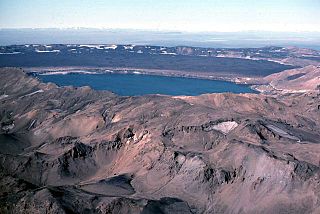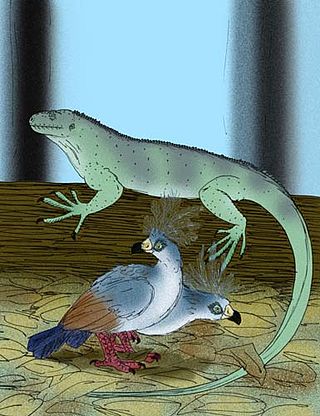Viti or Víti may refer to:
Viti or Víti may refer to:
A caldera is a large cauldron-like hollow that forms shortly after the emptying of a magma chamber in a volcano eruption. When large volumes of magma are erupted over a short time, structural support for the rock above the magma chamber is gone. The ground surface then collapses into the emptied or partially emptied magma chamber, leaving a large depression at the surface. Although sometimes described as a crater, the feature is actually a type of sinkhole, as it is formed through subsidence and collapse rather than an explosion or impact. Compared to the thousands of volcanic eruptions that occur each century, the formation of a caldera is a rare event, occurring only a few times per century. Only seven caldera-forming collapses are known to have occurred between 1911 and 2016. More recently, a caldera collapse occurred at Kīlauea, Hawaii in 2018.

Fiji, officially the Republic of Fiji, is an island country in Melanesia, part of Oceania in the South Pacific Ocean. It lies about 1,100 nautical miles north-northeast of New Zealand. Fiji consists of an archipelago of more than 330 islands—of which about 110 are permanently inhabited—and more than 500 islets, amounting to a total land area of about 18,300 square kilometres (7,100 sq mi). The most outlying island group is Ono-i-Lau. About 87% of the total population of 924,610 live on the two major islands, Viti Levu and Vanua Levu. About three-quarters of Fijians live on Viti Levu's coasts: either in the capital city of Suva; or in smaller urban centres such as Nadi—where tourism is the major local industry; or in Lautoka, where the sugar-cane industry is dominant. The interior of Viti Levu is sparsely inhabited because of its terrain.

Fiji is a group of volcanic islands in the South Pacific, lying about 4,450 kilometres (2,765 mi) southwest of Honolulu and 1,770 km (1,100 mi) north of New Zealand. Of the 332 islands and 522 smaller islets making up the archipelago, about 106 are permanently inhabited. The total land size is 18,272 km2 (7,055 sq mi). It has the 26th largest Exclusive Economic Zone of 1,282,978 km2 (495,361 sq mi).

Askja is an active volcano situated in a remote part of the central highlands of Iceland. The name Askja refers to a complex of nested calderas within the surrounding Dyngjufjöll [ˈtiɲcʏˌfjœtl̥] mountains, which rise to 1,514 m (4,967 ft), askja meaning box or caldera in Icelandic.
Ratu is an Austronesian title used by male Fijians of chiefly rank. An equivalent title, adi, is used by females of chiefly rank. In the Malay language, the title ratu is also the traditional honorific title to refer to the ruling king or queen in Javanese culture. Thus in Java, a royal palace is called "keraton", constructed from the circumfix ke- -an and Ratu, to describe the residence of the ratu.

Krafla is a volcanic caldera of about 10 km in diameter with a 90 km long fissure zone. It is located in the north of Iceland in the Mývatn region and is situated on the Iceland hotspot atop the Mid-Atlantic Ridge, which forms the divergent boundary between the North American Plate and the Eurasian Plate. Its highest peak reaches up to 818 m and it is 2 km in depth. There have been 29 reported eruptions in recorded history.

Mývatn is a shallow lake situated in an area of active volcanism in the north of Iceland, not far from Krafla volcano. It has a high amount of biological activity. The lake and the surrounding wetlands provides a habitat for a number of waterbirds, especially ducks. The lake was created by a large basaltic lava eruption 2300 years ago, and the surrounding landscape is dominated by volcanic landforms, including lava pillars and rootless vents (pseudocraters). The effluent river Laxá[ˈlaksˌauː] is known for its rich fishing for brown trout and Atlantic salmon.

Vanua Levu formerly known as Sandalwood Island, is the second largest island of Fiji. Located 64 kilometres to the north of the larger Viti Levu, the island has an area of 5,587.1 square kilometres (2,157.2 sq mi) and a population of 135,961 as of 2007.

Viti Levu is the largest island in the Republic of Fiji. It is the site of the nation's capital, Suva, and home to a large majority of Fiji's population.

Lakeba is an island in Fiji’s Southern Lau Archipelago; the provincial capital of Lau is located here. The island is the tenth largest in Fiji, with a land area of nearly 60 square kilometers. It is fertile and well watered, and encircled by a 29-kilometer road. Its closest neighbors are Aiwa and Nayau. Separated by deep sea from the latter but only by shallow waters from the former, when sea levels were lower during glacial episodes Lakeba and Aiwa formed one large island.

The Viti Levu giant pigeon or Fiji giant ground pigeon is an extinct flightless pigeon of Viti Levu, the largest island in Fiji. It was only slightly smaller than the dodo and Rodrigues solitaire and is the first giant flightless pigeon to be discovered on a Pacific island.

The pink-billed parrotfinch is a species of estrildid finch found on the island of Viti Levu, Fiji. Commonly found at undisturbed mature forest in the centre and east of Viti Levu, e.g. Joske's Thumb near Suva. This species is found at mid-height along tree-trunks and branches, usually alone or in pairs but also joining mixed-species flocks, feeding primarily on insects, but also on flower buds and fruits.

The Fiji goshawk is a species of bird of prey in the family Accipitridae. It was once considered to be the same species (conspecific) as the brown goshawk of Australia and New Caledonia. It is endemic to Fiji, where it occurs on the larger islands of Viti Levu, Vanua Levu, Taveuni, Kadavu, Gau and Ovalau. It occupies a range of wooded habitats in Fiji, from natural rainforest to coconut plantations and urban gardens and parks.
Eduard Heinrich Graeffe or Gräffe was a Swiss zoologist and naturalist. As an entomologist, he specialised in Hymenoptera, Diptera and Hemiptera.
Trevor Henry Worthy is an Australia-based paleozoologist from New Zealand, known for his research on moa and other extinct vertebrates.

The following outline is provided as an overview of and topical guide to Fiji:
Vitirallus watlingi, the Fiji rail or Viti Levu rail, was a prehistoric flightless bird from Fiji, and is the only species in the genus Vitirallus. Vitirallus watlingi is thought to have been about the same size as the bar-winged rail but with a very elongated and slender bill.

The Fiji tropical moist forests is a tropical moist forest ecoregion in Fiji and Wallis and Futuna. It covers the windward sides of Viti Levu and Vanua Levu, Fiji's largest islands, as well as the smaller Fijian islands and the three islands that make up Wallis and Futuna, an overseas territory of France.